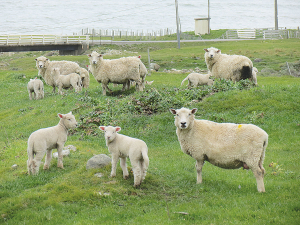Metabolic diseases primarily affect ewes in late pregnancy and sometimes early lactation. These can have a huge economic impact on a farming operation - especially if there are large losses of capital stock. In the second of two articles, we take a look at hypocalcaemia and hypomagnesaemia.
Hypocalcaemia
Sometimes referred to as milk fever. This disorder is caused by insufficient intake and absorption of calcium into the blood.
Predisposing Factors
Due to the demands of the developing foetal skeleton, a heavily pregnant ewe will need to mobilise some of her own skeletal calcium in order to meet her calcium requirement. Additional calcium goes into the milk.
Hypocalcaemia is most commonly seen in late pregnancy and early lactation, although it can occasionally occur in dry sheep.
The amount a ewe uses from her skeletal reserves depends on the diet she is consuming. These reserves must be replaced following lambing. If they are not, the ewe may be more susceptible to hypocalcaemia in subsequent pregnancies.
Lush, actively grown pasture, dry mature summer pastures, wheat or concentrate feeds containing low calcium (less than 1g/kg DM) and high phosphorus may predispose the ewe to hypocalcaemia. The main predisposing factors are hypocalcaemia are:
- Sudden changes in feed type or grazing regime
- Sudden increases in green feed
- Mustering and holding for crutching or shearing
- Access to sorrel or other oxalate-containing plants.
Clinical Signs
The diagnosis is usually based on a history of a sudden change of feed or method, clinical signs and a rapid response to treatment. Blood samples can also be taken to assess calcium levels (these should be taken from at least five ewes).
- Initially ewes will stagger and seem hyperactive.
- This rapidly progresses to the ewe becoming cast and then comatose. Their body position is usually one of sitting up with their head bent around to their flank.
- There may be no corneal reflex.
- You will often see bloating and regurgitation of stomach contents.
- Bearings (prolapse) can also occur in affected ewes
- Untreated animals will usually fall into a deep coma and die within 24 hours.
Treatment
Treatment with calcium borogluconate under the skin will result in a rapid (within 15-30 minute) response to treatment. The ewe will get up, urinate, walk away and start feeding. Muscle tremors may also be evident.
Low blood magnesium and glucose is also common in ewes affected with hypocalcaemia, therefore treatment with magnesium sulphate and glucose may also be warranted.
If the ewe does not respond quickly to treatment it may be necessary to treat for pregnancy toxaemia as this is a common effect of hypocalcaemia.
Prevention
Avoid stressful situations in late pregnancy and early lactation such as unnecessary mustering or yarding for long periods without feed. Introduce sheep gradually to any green feed crops.
Do not transport heavily pregnant ewes. Give calcium supplements to grain fed animals, especially during drought conditions where pasture is not available.
Hypomagnesaemia
This is also termed grass tetany or staggers (not to be confused with ryegrass staggers).
It is most commonly seen in mature lactating ewes, although it has also been seen occassionally in dry ewes.
Predisposing Factors
Magnesium absorption is influenced by many factors including decreased saliva production and/or increased potassium levels and decreased sodium in the rumen. Changing sheep from hay to lush pasture may bring on hypomagnesaemia, simply because the sheep may reduce the amount of chewing and salivating need to digest the feed.
There are virtually no body reserves of magnesium readily available, therefore animals are reliant on dietary intake of magnesium. The ewe's highest demand for magnesium is during lactation.
Hypomagnesaemia may be caused by the use of high rates of potassic fertiliser. The most common cause is inadequate feeding relative to energy demand, either due to inclement weather or under nutrition over a period of time.
Clinical Signs
Ewes affected with hypomagnesaemia are usually found dead in the paddock. Initially sheep will appear dull and stop eating. If disturbed these sheep may display muscle tremors and nervous signs (this is because magnesium is necessary for the central nervous system to function properly).
Other clinical signs include:
- Ewe collapsed on side with her head thrown back
- Severe comvulsions while paddling legs
- Frothing at the mouth
- Nystagmus (rapid rhythmic repetitive and involuntary eye movements, either horizontal, vertical or rotary)
- Rapid heartbeat and breathing.
Death usually occurs in four to six hours.
Treatment
As with all metabolic diseases, early detection and therapy greatly increase the success of treatment and recovery. The usual treatment is to inject magnesium sulphate and calcium borogluconate under the skin.
Ewes that respond positively to this treatment may also be drenched with magnesium oxide to boost their magnesium intake.
Other sheep within in the flock may also be suffering sub-clinically from low magnesium levels.
It is therefore advisable to administer magnesium oxide at a rate of 10 grams per sheep per day.
Increasing the amount of hay the flock consumes may also help to treat the rest of the flock by increasing salivation (this increases the sodium and potassium ration in the rumen).
Prevention
To prevent further cases in subsequent seasons, pay attention to increasing the intake of dietary magnesium, especially in mature ewes that may be carrying multiples.
You should also:
- Minimise stressful procedures such as yarding, trucking or mustering
- Introduce sheep gradually to lush feed and incorporate hay into their ration
- Provide adequate shelter
www.beeflambnz.com











